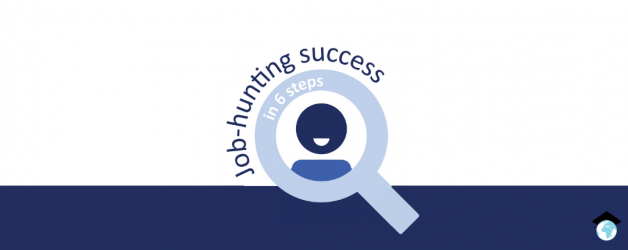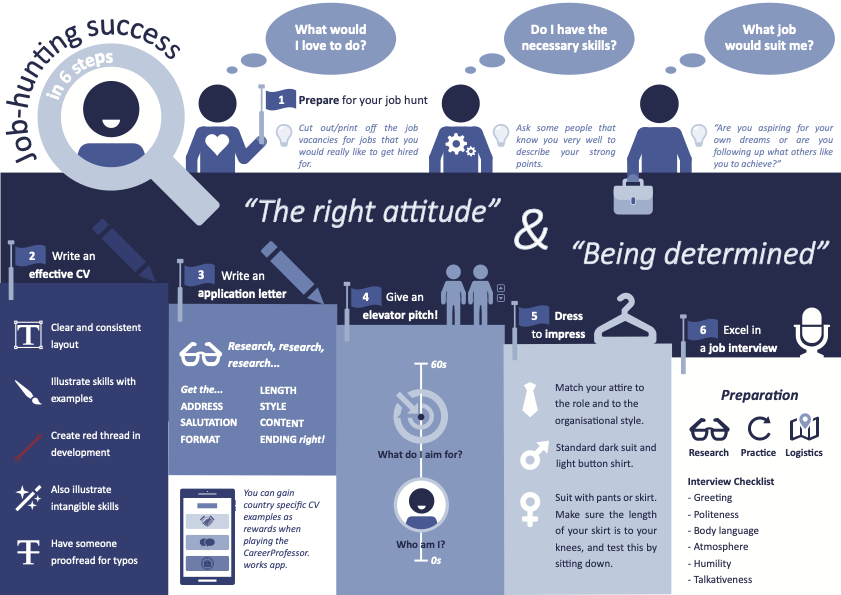Looking for a new job is always daunting, irrespective of your level of education or your level of experience. Apart from a few rare exceptions, most people find it scary to talk about themselves and make the other want to hire you. But finding the right sales pitch for yourself is what you need to do to get hired. This little guide with 6 steps for job-hunting success may get you off on the right track.
Step 1: Prepare for your job hunt
You may have heard this before: ‘find something you really enjoy doing, a job you like’. But that’s easier said than done, because … what do you really like? Over the years I’ve coached many people in all phases of their career and what seems to help in getting a good picture of the types of jobs you like, is collecting all jobs that appeal. No need to be harsh on yourself in this stage. Collect all job ads that mention something you relish, irrespective of the qualification needed, the required years of experience, or the compulsory skills. Once you have a good collection, start sorting it and try to find the red thread. This will most likely give you an indication of what you value in your work environment. And yes, dare to follow your heart.
Step 2: Write an effective CV
The challenge for a CV or resume is to get the balance right: do not oversell (forget talking about yourself in the 3rd person singular or adding skills that sound magnificent but for which you have no proof) but do not undersell either (as the reader needs to understand what you bring to a job and your CV should provide the evidence). Of course, you do not make a mistake in such an important document, but still … have someone check it for you, use a spellings checker, and proofread yourself the next day before sending it off. Typos are a definite no-no in a CV. Moreover, knowing your audience is key! A resume for the US does not contain a picture, your nationality, or your age, whereas a CV in Germany has no gaps and needs to be appropriately factual. Hence culture matters in CV writing.
Step 3: Write an application letter
Forget about sending 40 similar applications in a week – that’s 40 times wasted energy. An application or cover letter requires research and abundant attention. It’s the CV that causes the first attraction factor, but the letter does the trick. And if it needs to do the trick, make sure that you get the salutation right (preferably with the name – and correct gender! – of the person you are addressing). I can tell by experience, that when addressed by the wrong name, or being called Mr, and when the address features the wrong company name, it needs a lot to convince me to even read the application. The same goes for the ending of the letter, if you are applying for a 12-week internship do not end with “I’m looking forward to our fruitful cooperation”. You’ve missed the point as the goal of the letter is trying to convince the other that you would like to learn and gain experience in a short stint of 12-weeks. You’re not becoming business partners.
Step 4: Give an elevator pitch
It sounds too good to be true: you’re going up in a high rise building and you’re in the elevator with the hiring manager of the company you’ve always wanted to work for, and the person asks you about your future plans … and yes, it’s probably never going to happen, but just in case. Because the whole idea of that pitch is that you can explain who you are and what you aim for in just 60 seconds, whenever you must, and to whoever you meet. The trick? Think about your pitch, make a mental note of some essential keywords, and next ‘go with the flow’. Because every situation requires a slightly different pitch. Plus, the last thing you want is to sound as if you rehearsed your pitch in front of a mirror. Even if you did!
Step 5: Dress to impress
What to wear to an interview is a question that I’ve been asked so many times and most often the person asking felt a little awkward as if talking about appearances is somehow not entirely OK. We all know, you cannot judge a book by its cover, but in the hiring process, it does play a role (even if the interview happens online). Make sure you’ve checked for the country, company, and sector, so you know what’s common. Also pay attention to footwear, make-up, jewelry, and the (amount of) fragrance you wear. When in doubt, go for the more conservative choice. However, if you love a bright pink jacket, whereas your prospective colleagues all seem to wear dark suits, just go for it. Because if that jacket is truly reflecting your personality, you do not want to end up compromising even before getting hired.
Step 6: Excel in a job interview
The job interview is the cherry on the cake. Treat it like that. You’ve made it to this stage and that’s great, but beware, it’s not a guarantee you have got the job already. Again, preparation is key. What’s the organization about, what are the requirements for the role, how can you demonstrate you’ll fit the job? The interview is a pivotal moment in your career journey, but do not freak out when something does not go entirely as planned or when you get a question, and your answer is not 100% pitch-perfect. Remember the most important element of career success: there needs to be a click between you, the role, and the organization. Without that connection, it’s not going to work out (in the long run). Your recipe for success is daring to showcase you’ve got the skills and the capabilities and that works best when you include examples in your answers. Stay true to yourself in the conversation and think back to step 1: find a job you really like doing. If that’s the job you’re interviewing for, you’ll be radiating enthusiasm. And that’s half the job of getting the job.
©2021 Written by Nannette Ripmeester for CareerProfessor.works







